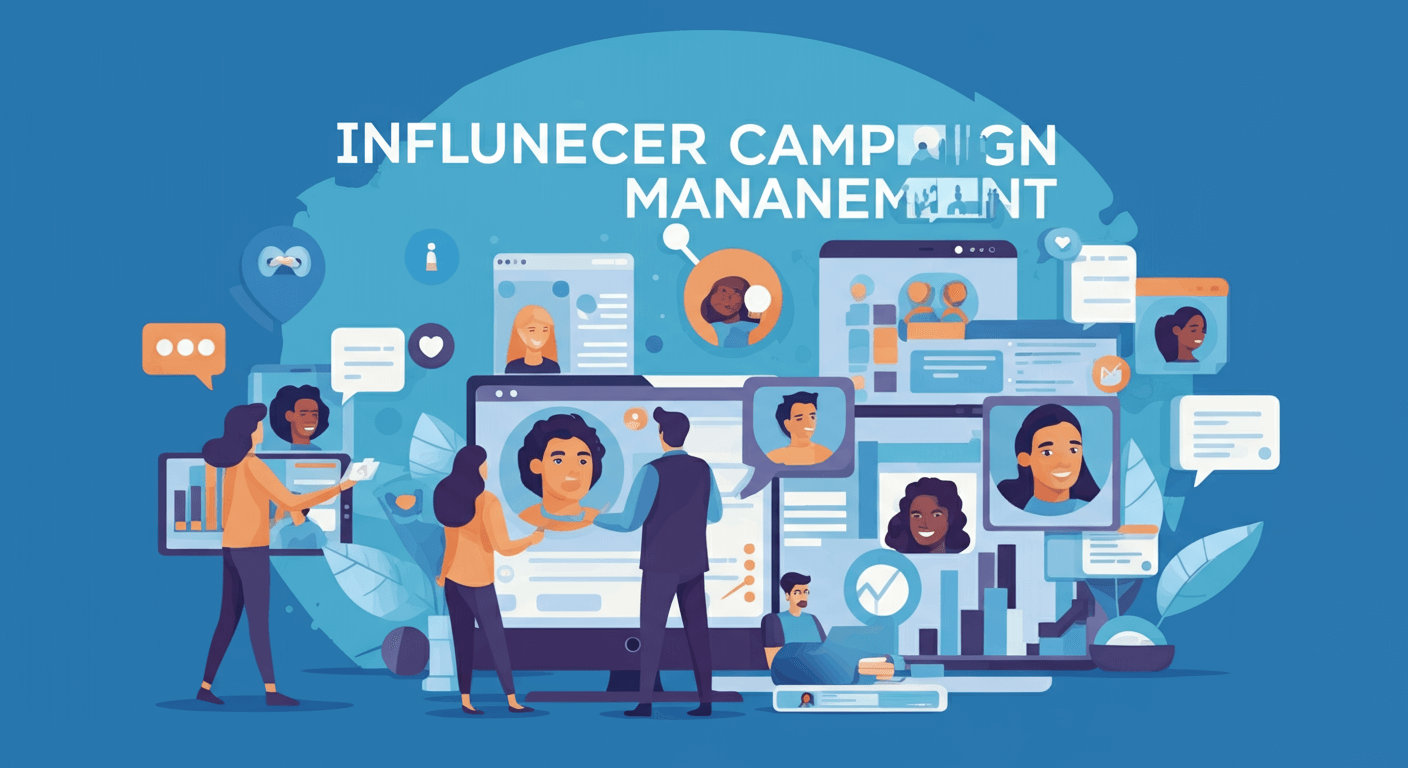The Ultimate Guide to Influencer Campaign Management

Influencer marketing has evolved from a niche strategy to a $21 billion industry, but success isn’t guaranteed simply by partnering with popular creators. The difference between campaigns that drive real results and those that fall flat often comes down to one critical factor: effective campaign management.
Managing influencer campaigns involves far more than finding creators with large followings and hoping for the best. It requires strategic planning, clear communication, performance tracking, and continuous optimization. Whether you’re launching your first influencer partnership or looking to improve existing campaigns, understanding the fundamentals of campaign management can transform your marketing efforts.
What is Influencer Campaign Management?

Influencer campaign management encompasses the end-to-end process of planning, executing, and optimizing marketing campaigns that involve content creators and social media influencers. It’s a comprehensive approach that goes beyond simply reaching out to influencers and asking them to post about your brand.
Effective campaign management involves coordinating multiple moving parts: identifying campaign objectives, selecting appropriate influencers, negotiating contracts, providing creative direction, monitoring content creation, tracking performance metrics, and analyzing results for future improvements.
The role typically includes both strategic and operational responsibilities. On the strategic side, campaign managers develop overall campaign goals, determine target audiences, and allocate budgets across different influencers and platforms. Operationally, they handle day-to-day communications, ensure content meets brand guidelines, manage payment schedules, and troubleshoot issues as they arise.
For a deeper understanding of influencer strategies, check out our Influencer Marketing Guide for Brands.
Setting Clear Campaign Objectives and KPIs
Before reaching out to any influencers, successful campaign management starts with establishing clear, measurable objectives. Without specific goals, it becomes impossible to evaluate campaign success or make data-driven improvements for future efforts.
Defining SMART Goals
Your campaign objectives should follow the SMART framework: Specific, Measurable, Achievable, Relevant, and Time-bound. Instead of vague goals like “increase brand awareness,” develop specific targets such as “generate 50,000 impressions among women aged 25-35 in the beauty category within 30 days.”
Common influencer campaign objectives include brand awareness, lead generation, sales conversion, community building, product launches, and reputation management. Each objective requires different approaches to influencer selection, content creation, and performance measurement.
Selecting Relevant KPIs
Key Performance Indicators (KPIs) should align directly with your campaign objectives. Brand awareness campaigns typically focus on reach, impressions, and share of voice metrics. Conversion-focused campaigns prioritize click-through rates, conversion rates, and return on ad spend (ROAS).
Engagement metrics like comments, shares, and saves provide insights into content resonance and audience interest. However, be cautious about vanity metrics that look impressive but don’t correlate with business outcomes. A post with 10,000 likes but zero website clicks may not be as valuable as one with 1,000 likes and 100 qualified leads.
Influencer Discovery and Vetting Process
Finding the right influencers represents one of the most critical aspects of campaign management. The goal isn’t to work with the most popular creators, but rather to identify influencers whose audiences align with your target demographics and whose content styles complement your brand values.
Research and Identification Strategies
Start your influencer search by examining your existing customer base and brand mentions. Look for customers who already create content featuring your products or services naturally. These authentic brand advocates often make the most effective partners because their endorsements feel genuine rather than purely transactional.
Social media platforms offer various discovery tools. Instagram’s Creator Discovery feature allows brands to search for creators by location, audience demographics, and content categories. TikTok’s Creator Marketplace provides similar functionality with additional insights into creator performance metrics.
Third-party platforms like AspireIQ, Upfluence, and Grin offer more sophisticated search capabilities, including audience demographic analysis, engagement rate calculations, and historical performance data. These tools can significantly streamline the discovery process, especially for larger campaigns requiring multiple influencers.
Vetting and Evaluation Criteria
Once you’ve identified potential influencers, thorough vetting ensures you partner with creators who can deliver on campaign objectives. Examine their content quality, posting consistency, audience engagement patterns, and brand alignment.
Analyze their follower demographics to confirm alignment with your target audience. An influencer with 100,000 followers means little if only 5% match your ideal customer profile. Look for creators whose audiences demonstrate genuine engagement through meaningful comments and discussions rather than generic responses.
Review their previous brand partnerships to assess professionalism and content quality. Have they worked with competitors? How did they disclose sponsored content? Do their previous campaigns align with FTC guidelines? These factors indicate how they might represent your brand.
Campaign Planning and Strategy Development
Effective campaign management requires detailed planning that considers every aspect of the influencer partnership, from initial outreach to final performance analysis. This planning phase sets the foundation for campaign success and helps prevent common issues that can derail influencer partnerships.
Content Strategy and Creative Direction
Develop clear creative guidelines that maintain brand consistency while allowing influencers creative freedom. The most successful influencer content feels authentic to the creator’s usual style while incorporating your brand messaging naturally.
Create a creative brief that outlines key messaging points, required brand mentions, visual guidelines, and any mandatory disclaimers or hashtags. However, avoid being overly prescriptive. Influencers understand their audiences better than anyone, so provide direction without stifling their creativity.
Consider the unique characteristics of each social media platform. Instagram Stories require different approaches than YouTube videos or TikTok posts. Tailor your creative requirements to leverage each platform’s strengths and align with user expectations.
Timeline and Logistics Planning
Develop realistic timelines that account for content creation, review processes, revisions, and posting schedules. Most influencers need adequate lead time to create quality content, especially for complex formats like video content or elaborate photo shoots.
Build buffer time into your timeline for unforeseen delays or revision requests. Content that requires legal review, medical claims, or regulatory compliance may need additional approval time. Plan for these requirements upfront rather than discovering them at the last minute.
Coordinate posting schedules to maximize campaign impact. Staggered posts can extend campaign duration and maintain consistent visibility, while simultaneous posts can create momentum for product launches or special events.
Communication and Relationship Management

Strong relationships with influencers often determine campaign success more than follower counts or engagement rates. Effective communication builds trust, ensures smooth campaign execution, and increases the likelihood of future partnerships.
Initial Outreach Best Practices
Personalize your initial outreach messages to demonstrate genuine interest in the influencer’s content and audience. Reference specific posts you enjoyed or explain why their audience aligns with your brand. Generic mass messages often get ignored or deleted.
Be transparent about campaign expectations, deliverables, timeline, and compensation from the beginning. Influencers appreciate clear communication and are more likely to respond positively when they understand exactly what you’re proposing.
Provide easy ways for influencers to learn more about your brand and campaign objectives. Include links to your website, product pages, and previous successful influencer collaborations. The more information you provide upfront, the easier it becomes for influencers to evaluate partnership opportunities.
Ongoing Communication Strategies
Establish regular check-in schedules to monitor progress without being overly intrusive. Weekly status updates work well for longer campaigns, while daily check-ins might be appropriate for time-sensitive launches.
Create clear communication channels and response time expectations. Let influencers know the best ways to reach you and when they can expect responses to questions or approval requests. Slow communication from brands often leads to missed deadlines and frustrated partnerships.
Be responsive and flexible when influencers encounter challenges or propose changes. Their insights into their audiences can improve campaign performance, so remain open to their suggestions and feedback.
Performance Tracking and Analytics
Measuring influencer campaign performance requires both quantitative metrics and qualitative assessment. The key is tracking metrics that align with your campaign objectives while gathering insights that inform future campaign improvements.
Essential Metrics to Monitor
Track reach and impressions to understand campaign visibility and potential audience exposure. However, focus on quality metrics like engagement rates, click-through rates, and conversion metrics that indicate genuine audience interest and campaign effectiveness.
Monitor brand mention sentiment and share of voice to assess how influencer content affects brand perception. Tools like Brandwatch, Mention, and Hootsuite Insights can track mentions across multiple platforms and provide sentiment analysis.
Use unique tracking links, promo codes, and UTM parameters to measure direct campaign attribution. These tools help quantify the immediate impact of influencer content on website traffic, lead generation, and sales conversion.
Tools and Platforms for Measurement
Most social media platforms provide native analytics tools that offer basic performance insights. Instagram Insights, YouTube Analytics, and TikTok Analytics show reach, engagement, and audience demographic data for individual posts and overall account performance.
Third-party analytics platforms like Socialbakers, Sprout Social, and Later provide more comprehensive measurement capabilities, including competitor analysis, hashtag performance tracking, and cross-platform campaign comparison.
For e-commerce brands, tools like Google Analytics, Shopify Analytics, and specialized influencer marketing platforms can track the customer journey from influencer content to final purchase, providing clearer ROI calculations.
Legal and Compliance Considerations
Influencer campaign management must address legal requirements and compliance issues to protect both brands and creators. Failure to follow proper disclosure guidelines can result in regulatory penalties and damage to brand reputation.
FTC Guidelines and Disclosure Requirements
The Federal Trade Commission requires clear disclosure of paid partnerships between brands and influencers. Disclosures must be obvious and understandable to average consumers, appearing prominently within the content rather than buried in hashtag lists.
Use clear disclosure language like “#ad,” “#sponsored,” or “#paidpartnership” rather than ambiguous terms like “#collab” or “#thanks.” The disclosure should appear early in the content where users will notice it without having to click “more” or scroll extensively.
Ensure influencers understand disclosure requirements and include them in your creative brief and contract terms. Provide examples of proper disclosure methods for different content formats and platforms.
Contract and Agreement Management
Develop comprehensive influencer agreements that outline deliverables, timelines, payment terms, usage rights, and performance expectations. Clear contracts prevent misunderstandings and provide recourse if issues arise.
Address content ownership and usage rights explicitly. Determine whether you need perpetual usage rights, specific duration licenses, or rights for particular marketing channels. These rights often affect compensation negotiations.
Include clauses addressing content quality standards, revision processes, and termination conditions. These provisions protect your brand while ensuring influencers understand their responsibilities and your expectations.
Budget Management and ROI Optimization
Effective budget management ensures you maximize campaign impact while maintaining sustainable influencer marketing investments. This involves both strategic budget allocation and ongoing optimization based on performance data.
Pricing and Negotiation Strategies
Influencer pricing varies dramatically based on follower count, engagement rates, content format, usage rights, and exclusivity requirements. Research industry benchmarks but remember that the right influencer for your brand may command premium pricing if they deliver superior results.
Consider value beyond follower counts when negotiating compensation. An influencer with 50,000 highly engaged followers in your exact target demographic may deliver better ROI than a creator with 500,000 loosely aligned followers.
Negotiate package deals for multiple posts or long-term partnerships. Many influencers offer discounts for ongoing collaborations, and extended partnerships often yield better results as creators become more familiar with your brand and messaging.
Maximizing Campaign ROI
Allocate budget based on historical performance data when possible. If micro-influencers consistently outperform macro-influencers for your brand, adjust budget allocation accordingly rather than chasing vanity metrics.
Repurpose high-performing influencer content across your owned marketing channels. With proper usage rights, successful influencer content can enhance your social media accounts, website, email campaigns, and paid advertising efforts.
Test different campaign approaches with smaller budget allocations before scaling successful strategies. This approach minimizes risk while identifying the most effective influencer types, content formats, and messaging approaches for your brand.
Common Challenges and Solutions
Every influencer campaign management process encounters challenges, but understanding common issues and their solutions helps prevent problems and respond effectively when they arise.
Managing Multiple Influencers
Coordinating campaigns across multiple influencers requires systematic organization and clear communication protocols. Create standardized processes for onboarding, content review, and payment processing to ensure consistency across all partnerships.
Use project management tools like Asana, Trello, or specialized influencer marketing platforms to track deliverables, deadlines, and approval statuses across multiple campaigns simultaneously. These tools provide visibility into campaign progress and help identify potential bottlenecks before they become problems.
Establish clear escalation procedures for addressing issues quickly. When problems arise with one influencer, having predetermined solutions prevents delays that could affect other campaign components.
Dealing with Underperforming Content
Not every piece of influencer content will meet expectations, but having clear performance thresholds and response protocols helps address underperformance constructively.
Review content performance against established KPIs and provide specific feedback for improvement. Rather than simply stating that performance was disappointing, identify specific areas like engagement rates, click-through rates, or message clarity that need attention.
Work with underperforming influencers to understand potential issues and develop solutions. Sometimes poor performance results from misaligned posting times, unclear calls-to-action, or audience mismatch rather than content quality problems.
Future-Proofing Your Influencer Campaign Management
The influencer marketing landscape continues evolving rapidly, with new platforms, content formats, and audience behaviors emerging regularly. Successful campaign management requires staying current with these changes while building flexible strategies that adapt to new opportunities.
Emerging Trends and Technologies
Artificial intelligence and machine learning tools are increasingly sophisticated at identifying high-potential influencers and predicting campaign performance. These technologies can streamline influencer discovery and improve budget allocation decisions.
Live streaming and interactive content formats are growing in popularity across platforms. Consider how these formats might enhance your campaigns and provide more authentic ways for influencers to showcase your products or services.
Virtual and augmented reality technologies are creating new opportunities for immersive influencer content. While still emerging, brands should monitor these developments for potential competitive advantages.
Building Long-Term Strategies
Focus on developing ongoing relationships with high-performing influencers rather than treating each campaign as a one-time transaction. Long-term partnerships often yield better results as creators become genuine advocates for your brand.
Invest in understanding your audience’s preferred platforms and content consumption habits. Platform popularity can shift quickly, so maintaining flexibility in your approach ensures you can adapt to changes in user behavior.
Taking Your Influencer Campaigns to the Next Level
Successful influencer campaign management combines strategic planning, operational excellence, and continuous optimization based on performance data. The brands that excel in this space treat influencer partnerships as collaborative relationships rather than simple advertising transactions.
Start by implementing the fundamental practices outlined in this guide: clear objective setting, thorough influencer vetting, comprehensive campaign planning, and robust performance measurement. As you develop experience and gather data, refine your approach based on what works best for your specific brand and audience.
Remember that influencer marketing effectiveness often improves over time as you build relationships with creators and better understand your audience preferences. Focus on sustainable practices that support long-term success rather than short-term metrics that don’t drive business results.
The influencer marketing landscape will continue evolving, but brands that master the fundamentals of campaign management will be well-positioned to adapt to new opportunities and maintain competitive advantages in an increasingly crowded marketplace.





